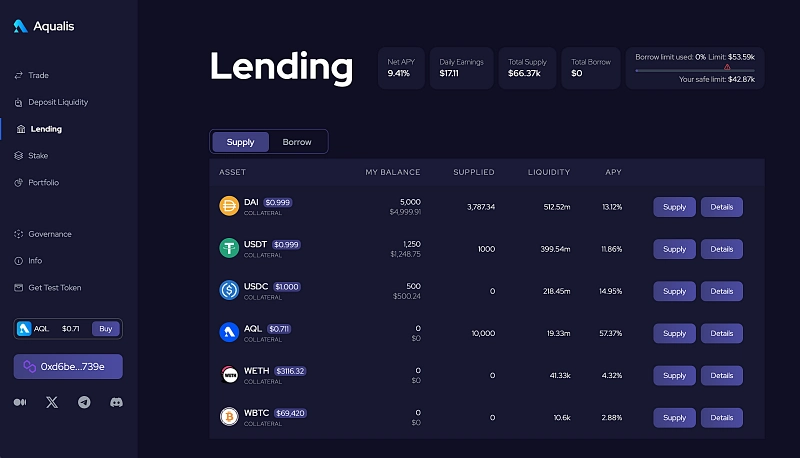To power the Aqualis lending protocol, the AMU AI will dynamically allocate up to 80% of under-utilized funds from the SP into the lending smart contract where users can take out overcollateralized loans by depositing cryptocurrencies. These cryptocurrency collaterals will be further used as lendable assets for users with SP/stablecoin deposits. Users can take additional borrowing or repay their loan at any time, provided they are within the LTV parameters. The Aqualis lending protocol is simply a fork of Aave v3, with the SP's AMU AI integration.
This structure is battle tested and proven by existing protocols such as Aave and Venus which allow users to have fully collateralized loans, while earning interest on their collateral. However, with the additional efficiency Aqualis offers through the interoperability of the SP smart contract, Aqualis can offer lower fees while maintaining high yields for depositors.
Initial and Liquidation LTV Ratio (tentative values)
Users will initially be able to borrow up to 70% (varies between assets) of their deposited funds as a loan. When this ratio grows up to 85% (varies between assets), users will be at risk of liquidation. Users can simply repay a portion of their loan or add additional collateral to prevent liquidations.
Please note these parameters are subject to change and it will also vary based on asset type.
Liquidations will be performed by decentralized bots that monitor the health of all loans in the ecosystem. Should a liquidation event happen, the user will be subject to a small fee, currently planned to be 4%, with 50% of this fee going to the liquidator as a bounty, and 50% will go towards the DAO Controlled Insurance Fund (DCIF), explained below.
SP Integration (Phase 1)
To put all this into effect, we have developed the AMU AI algorithm that dynamically allocates funds to and from trading into lending. Parameters that control these movements include:
- Minimum SP Liquidity: The minimum amount of stablecoins in the SP before it starts getting allocated to lending
- Optimal Liquidity Ratio: Once the minimum SP liquidity is fulfilled, excess funds are allocated to lending until we reach the optimal liquidity ratio, once this is reached, the algorithm aims to maintain this
- Tolerance Threshold: The minimum amount of imbalance required before a rebalance is deemed necessary between the liquidity pools
Once a rebalance is deemed necessary, a transfer of funds will occur via a trustless function that can be called by anyone in the community. The goal is to incentivize this by providing a small AQL reward for users who perform this function that will hopefully cover gas costs, the rewards will increase depending on the amount of AQL transferred and time since last transfer.
A transfer from SP into lending will be based entirely on the liquidity ratio in the SP to ensure it does not affect the trading fees in the SP. A transfer from lending into SP will take into account the product of the liquidity ratios, ensuring sufficient liquidity in lending while maintaining a minimal effect on the liquidity ratio in the SP. This is to ensure users do not take advantage of shifting liquidities and negative trading fees.
Loan Repayments
Users can repay their loan at any time, interest (detailed in the Fee Structure page) will be calculated and charged in real time and impact the LTV ratio. Additional collateral may be added to decrease LTV or funds taken out to increase LTV at any time provided it adheres to the maximum LTV parameter. Users can cross collateralize their cryptocurrencies to minimize the chance of liquidation, or strictly only use selected assets as collateral to minimize liquidation amount.
Interest Rates
Interest rates will be variable by default, depending on the supply and demand of the specific asset. Aqualis aims to achieve high depositor rewards through a high utilization rate, so interest rate curves may be adjusted over time.
Aqualis currently plans to allow users to opt for a fixed interest rate. This rate will have a minimum rate but if the time weighted average variable rate is above the minimum, the fixed rate will be calculated as the current variable rate plus some premium. More research will be done on this prior to implementation.
Bad Debt Budget (BDB)
Liquidation fees that go to the BDB will act as protocol owned liquidity, but it will not be deposited back into Aqualis LPs to mitigate any potential downside risk.
The main purpose of this budget is to protect users in the event of a protocol level hack, liquidation mistake or bad debt. All transactions out of this smart contract will need to first be approved by the DAO.
This wallet is not intended to be used for any operational costs, at any point in time.

